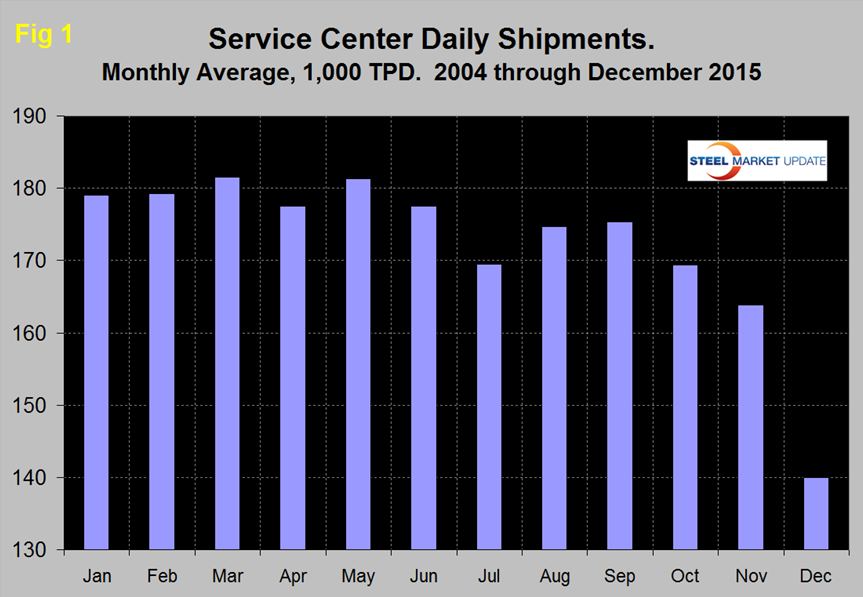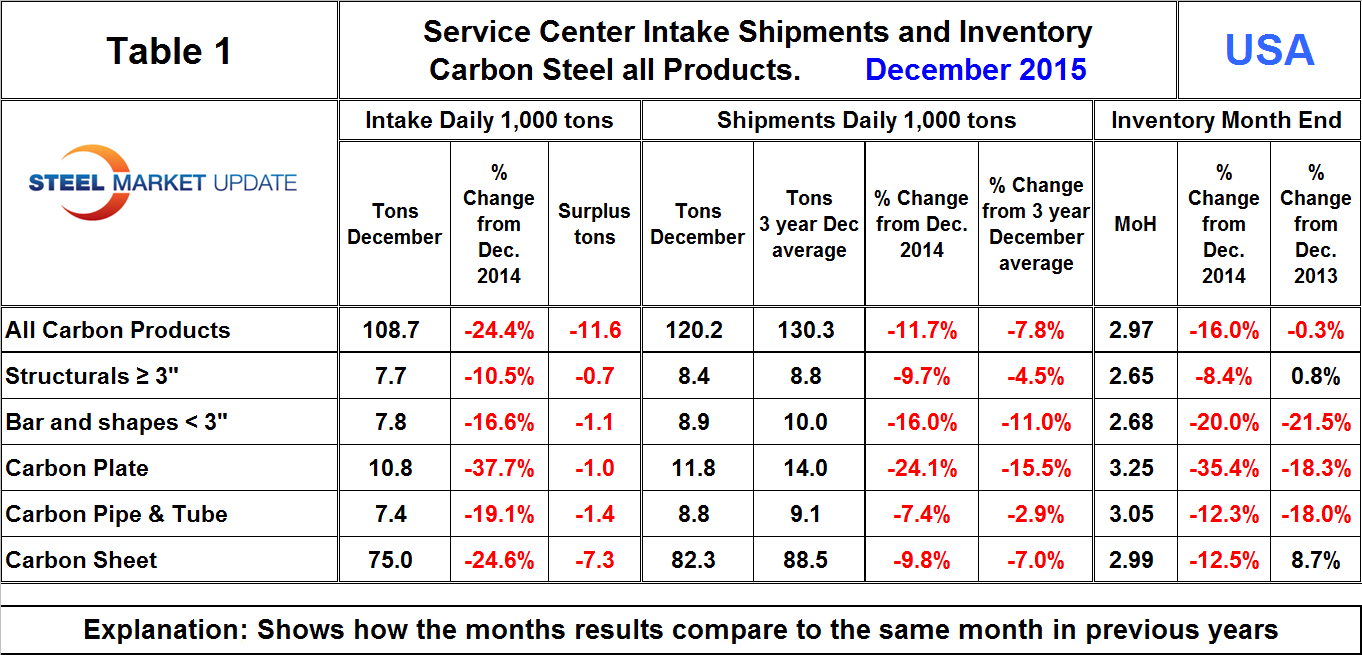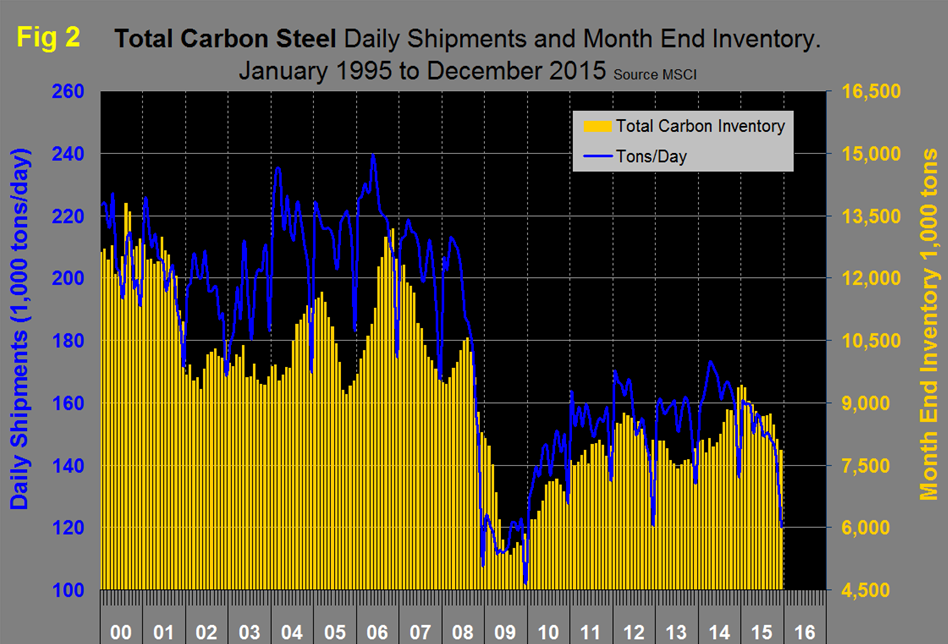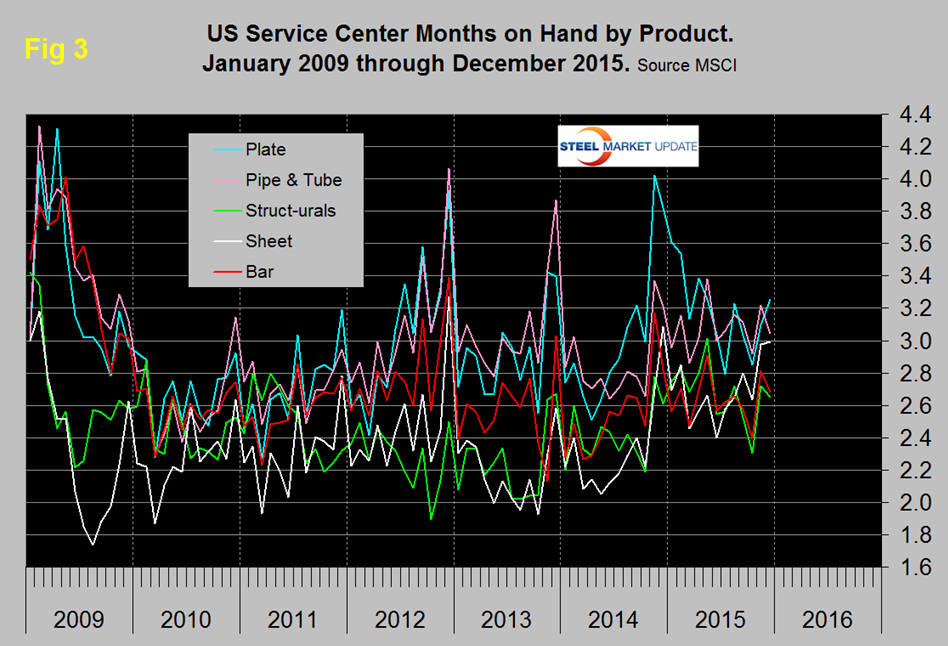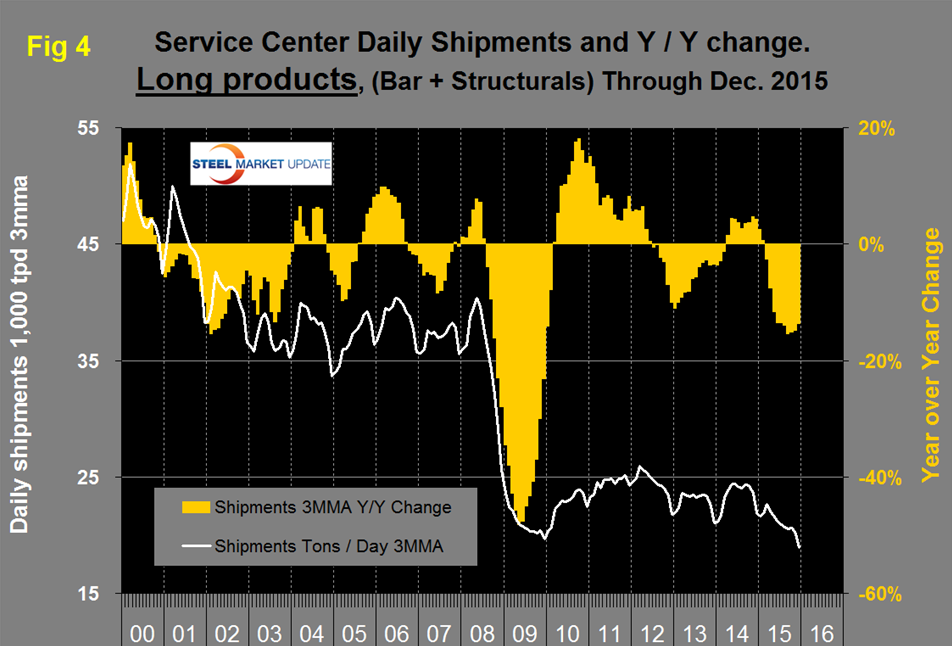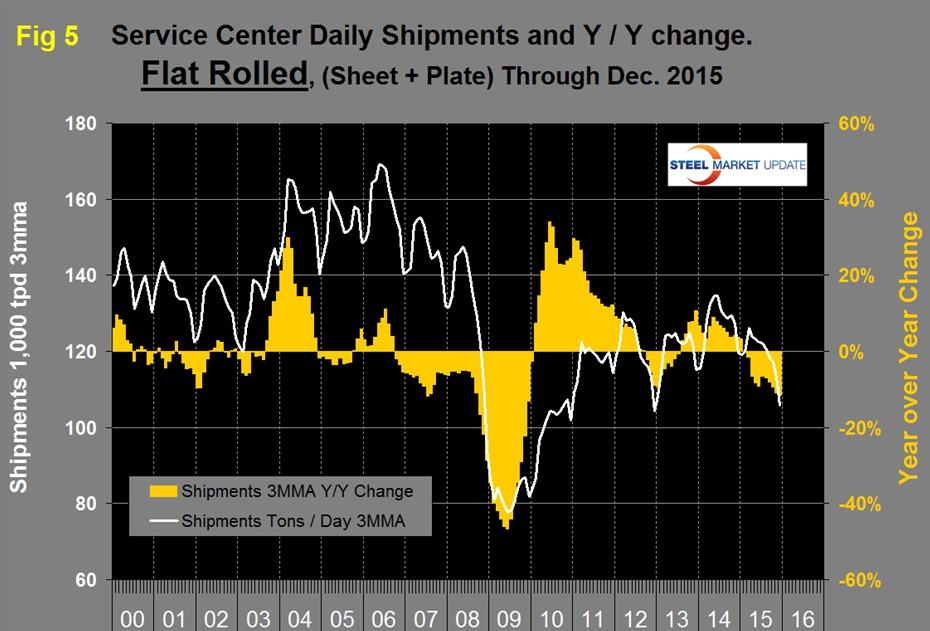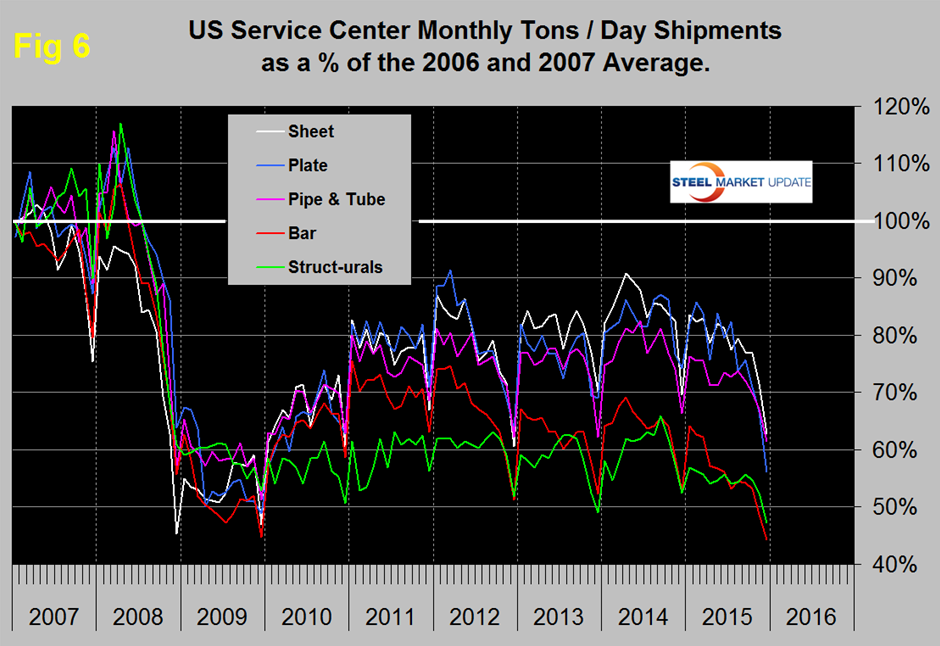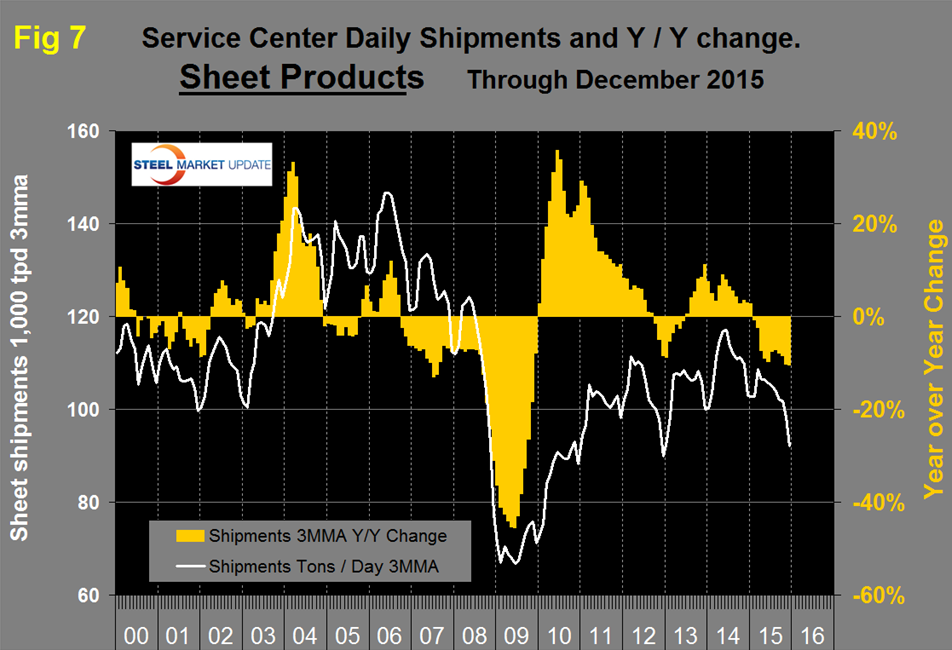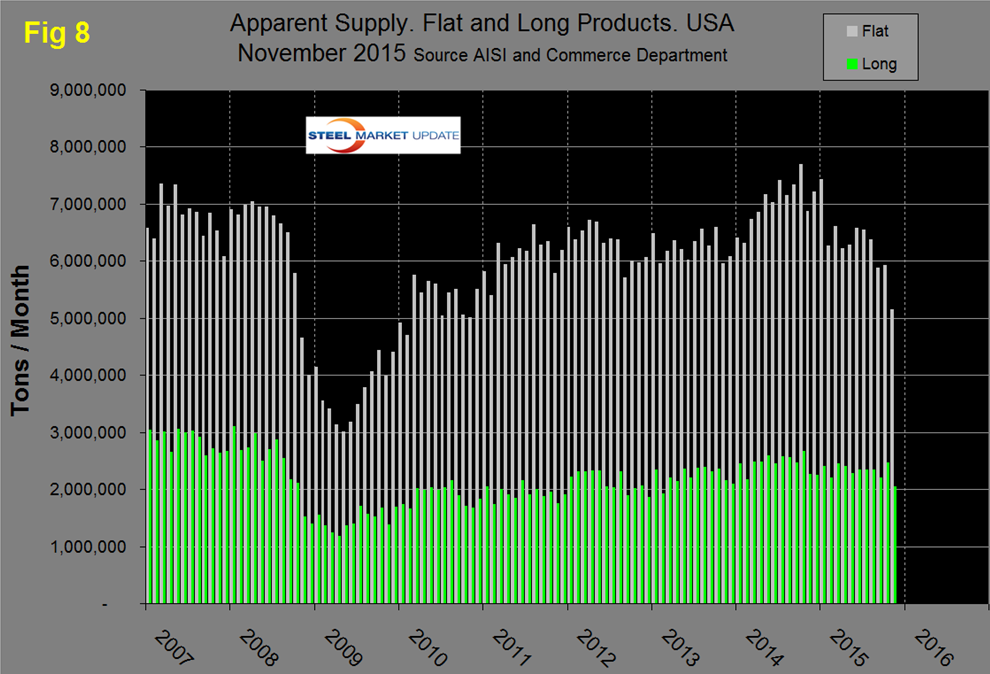Market Segment

January 19, 2016
Service Center Intake, Shipments and Inventory through December 2015
Written by Peter Wright
The article below is normally reserved for our Premium members, but we thought our Executive members would appreciate seeing the MSCI data from a different viewpoint with more analysis than what they normally see from us.
Based on Steel Market Update (SMU) analysis of the recently released MSCI service center inventory and shipment data, total service center carbon steel shipments decreased by 83,900 tons in December to 2.644 million tons. Shipping days at 22, were up by two from November. On a tons per day basis (t/d) shipments decreased from 136,400 tons in November to 120,200 tons in December.
![]()
In the seven years since 2009 December shipments on average have been down by 13.2 percent from November, this year shipments were down by 11.9 percent. Therefore on a long term basis (7 years) the December performance compared to November was a little bit better than normal. This observation is only intended to give a long term perspective because MSCI data is extremely seasonal and we need to get past that before commenting in detail on current results. Figure 1 demonstrates this seasonality and why comparing a month’s performance with the previous month is usually misleading. We are now in a period when shipments in t/d have decreased for three consecutive months and will bounce back in January. In the SMU analysis we always consider year over year changes to eliminate seasonality.
Table 1 shows the performance by product in December compared to the same month last year and also with the average t/d shipments for December in the last three years. We then calculate the percent change between December 2015 and December 2014 and with the 3 year December average. Our intention is to provide an undistorted view of market direction.
In December intake at 108,700 t/d was 11,600 tons less than shipments. This was the third month of deficit after three straight months of surplus. The intake deficit was evident for all product groups. Compared to December 2014, intake was down by 24.4 percent overall and all product groups were down by double digits.
Shipments of all products on a t/d basis were down by 11.7 percent from December 2014 and were 7.8 percent less than the average December shipments for 2015, 2014 and 2013. The fact that the single month y/y growth comparison is worse than the three year comparison is an indication that momentum is negative and the contraction is accelerating. Figure 2 shows the long term trends of daily shipments and month end inventory since 2000.
Daily shipments had a post recessionary high of 173,300 in April 2014 and have had a downward trend ever since. In December shipments of all products were down by a minimum of 7.1 percent year over year. Carbon plate at -24.1 percent had the highest contraction y/y followed by bars + light shapes at -16.0 percent. Carbon sheet was down by 9.8 percent. In the December data the MSCI enhanced its granularity and broke sheet down into hot rolled, cold rolled and coated products. In our next update we will report on this finer detail.
December closed with months on hand (MoH) of 2.97, down from 2.98 at the end of November. All products except structurals had a double digit y/y decrease in MoH. Structurals declined by 8.4 percent. Figure 3 shows the MoH by product monthly since January 2009. Plate has re-gained the top spot after recovering from the extremely high inventory levels at the end of 2014.
There continues to be a wide difference between the performances of flat rolled (sheet + plate) and long products (structurals + bar) at the service center level. Long products have had a very poor recovery from the recession. On a 3MMA basis y/y, the growth of long product shipments was negative for 21 straight months until April last year which was the first of eleven months of growth. However in March on a y/y basis shipment growth returned to negative territory and has stayed there ever since with double digit contraction for each of the last eight months (Figure 4).
Considering the improving construction statistics, we have no explanation for this dismal and deteriorating long product performance other than that possibly more customers are bypassing service centers and buying direct from mill inventories. Flat rolled has had a much better recovery since mid-2009 and had positive y/y growth for 18 straight months through January 2015. In February growth slowed to zero, in March came in at negative 1.6 percent and has been negative ever since (Figure 5).
In 2006 and 2007, the mills and service centers were operating at maximum capacity. Figure 6 takes the shipments by product since that time frame and indexes them to the average for 2006 and 2007 in order to measure the extent to which service center shipments of each product have recovered.
Again it can be seen that bars and structurals have the worst record and that bars + light shapes had a particularly severe deterioration in 2015. Sheet, plate and tubulars are now showing a deteriorating trend since mid-year. The total of carbon steel products is now at 56.6 percent of the shipping rate that existed in 2006 and 2007, with structurals and bar at 47.3 percent and 44.3 percent respectively. Sheet is at 62.9 percent, plate at 56.2 percent and tubulars at 61.5 percent.
MSCI uses product nomenclature flat and plate. In this analysis at SMU we replace the term flat with sheet. MSCI’s definition of “flat” is all hot rolled, cold rolled and coated sheet products. Since most of our readers are sheet oriented we have removed plate from Figure 5 to highlight the history of sheet products which are shown in Figure 7.
Following the strong post-recession recovery, sheet products experienced 9 months of decline from December 2012 through June 2013. This was followed by 18 months of growth through January 2015 but February slipped back into negative territory at – 0.7 percent year over year and has been negative ever since with a double digit decline in November and December.
SMU Comment: Figures 2, 4, 5 and 7 show that there has been a distinct decline in shipments for all products since the middle of last year. This MSCI data is now looking more like our report of total supply to the market which is based on AISI shipment and import data. Total supply of flat rolled products peaked in December last year, dropped sharply in February then through August didn’t change much. However in November supply was the lowest since March 2010 as shown in Figure 8. Note that this supply data is one month behind the MSCI information.
The SMU data base contains many more product specific charts than can be shown in this brief review. For each product we have ten year charts for shipments, intake, inventory tonnage and months on hand. Some readers have requested these extra charts for a particular product and others are welcome to do so.



